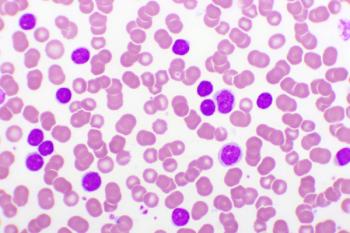
Monoclonal Gammopathy Subtypes Associated With CLL Outcomes
Key Takeaways
- Monoclonal gammopathy subtypes, especially IgM-MG, define distinct clinical subsets in CLL, impacting therapeutic outcomes significantly.
- IgM-MG is linked to poorer prognostic indicators, including unmutated IGHV, TP53 aberrations, and shorter progression-free and overall survival.
Patients with immunoglobulin M-type monoclonal gammopathy did not experience a survival benefit from targeted therapies, a study found.
Monoclonal gammopathy (MG) subtypes appear to represent distinct subsets of
The report, which was
MG is common in B-cell non-Hodgkin lymphoma, wrote corresponding author Shuhua Yi, MD, PhD, of the Chinese Academy of Medical Sciences and Peking Union Medical College, and colleagues. For instance,
Yet, Yi and colleagues said the prognostic value of MG in CLL “remains contentious,” due to conflicting outcomes in previous trials.1 The investigators said the majority of recent evidence supports the idea that MG status is important. However, they said it has been difficult to draw firm conclusions due to limitations associated with the previous studies, including single-center cohorts, heterogenous MG-detection methods, and insufficient numbers of patients treated with modern targeted agents, like Bruton tyrosine kinase (BTK) inhibitors and B-cell lymphoma 2 (BCL-2) inhibitors.
“To bridge these critical gaps, we studied a large retrospective cohort of 2075 CLL patients,” the authors explained. The patients in the new report were diagnosed with CLL at Yi’s institution between 1999 and 2024.
Within that cohort, the investigators identified MG in 226 patients (18.47%). Among those, IgM-MG (100 patients) and IgG-MG (99 patients) were the most common subsets of MG. In addition to those patients, 14 patients had light-chain-type MG, and 13 patients had IgA-MG. The authors found that the lambda-type was the most common among those with light-chain MG, but there was no significant light-chain preference among the other types of MG.
The investigators found certain demographic differences between the subtypes. For instance, patients with IgA-MG tended to be older at diagnosis, with a median age at diagnosis of 66.38 years, compared to 58.88 years for patients with IgG-MG, and 60.17 years for patients with IgM. Patients with IgG also had a higher frequency of mutated immunoglobulin heavy-chain variable (IGHV).
However, the investigators found IgM-MG to be the most notable subtype. Patients with IgM-MG had higher rates of unmutated IGHV, elevated LDH and β2-microglobulin, and higher frequencies of TP53 aberrations and enrichment of MYD88, BIRC3, DDX3X mutations, the authors said.
IgM-MG CLL was also associated with shorter times to first treatment (TTFT), and shorter progression-free survival (PFS) and overall survival (OS). For example, patients with IgM-MG CLL had a median PFS of 31 months, compared to 48 months among patients with MG-negative CLL. Patients with IgG-MG had a shorter TTFT compared to MG-negative patients, but no significant differences in the other outcome categories. Patients with lambda light-chain MG had shorter PFS, but comparable TTFT and OS times, the authors found. Patients with IgA-MG had no significant survival differences with MG-negative patients.
Yi and colleagues also found that patients with IgM-MG had notably different treatment outcomes. Specifically, they found that these patients did not see a survival benefit when treated with targeted therapies instead of conventional regimens.
The authors concluded that their findings show MG status can be an important prognostic tool for clinicians.
“These findings demonstrate that MG subtypes, particularly IgM-MG, define biologically and clinically distinct subsets of CLL,” they wrote. “Given the limited efficacy of BTK inhibitors in IgM-MG, immunofixation-based MG profiling may inform risk-adapted treatment strategies and personalized therapy selection.”
References
1. Yan Y, Yuan B, Qiu T, et al. Monoclonal gammopathy defines distinct clinical subsets in chronic lymphocytic leukemia across therapeutic eras. Blood Adv. Published online September 3, 2025. doi:10.1182/bloodadvances.2025017057
2. Cox MC, Esposito F, Postorino M, Venditti A, Di Napoli A. Serum paraprotein is associated with adverse prognostic factors and outcomes across different subtypes of mature B-cell malignancies—a systematic review. Cancers (Basel). 2023;15(18):4440. doi:10.3390/cancers15184440
Newsletter
Stay ahead of policy, cost, and value—subscribe to AJMC for expert insights at the intersection of clinical care and health economics.







































